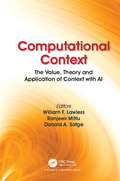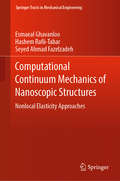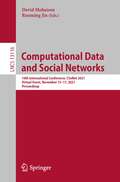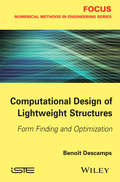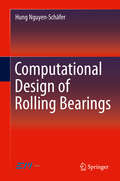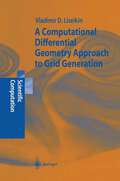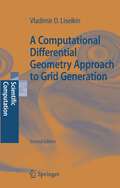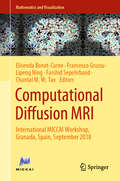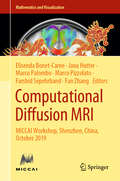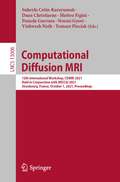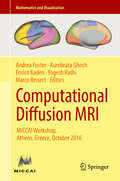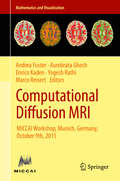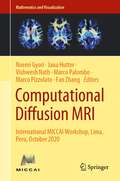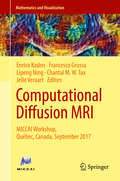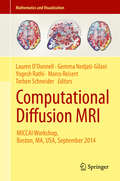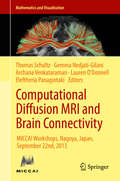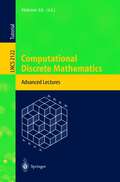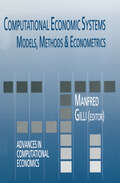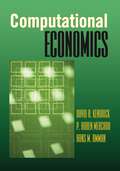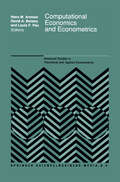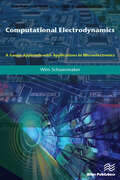- Table View
- List View
Computational Context: The Value, Theory and Application of Context with AI
by William F. Lawless Ranjeev Mittu Donald SofgeThis volume addresses context from three comprehensive perspectives: first, its importance, the issues surrounding context, and its value in the laboratory and the field; second, the theory guiding the AI used to model its context; and third, its applications in the field (e.g., decision-making). This breadth poses a challenge. The book analyzes how the environment (context) influences human perception, cognition and action. While current books approach context narrowly, the major contribution of this book is to provide an in-depth review over a broad range of topics for a computational context no matter its breadth. The volume outlines numerous strategies and techniques from world-class scientists who have adapted their research to solve different problems with AI, in difficult environments and complex domains to address the many computational challenges posed by context. Context can be clear, uncertain or an illusion. Clear contexts: A father praising his child; a trip to the post office to buy stamps; a policewoman asking for identification. Uncertain contexts: A sneak attack; a surprise witness in a courtroom; a shout of "Fire! Fire!" Contexts as illusion: Humans fall prey to illusions that machines do not (Adelson’s checkerboard illusion versus a photometer). Determining context is not easy when disagreement exists, interpretations vary, or uncertainty reigns. Physicists like Einstein (relativity), Bekenstein (holographs) and Rovelli (universe) have written that reality is not what we commonly believe. Even outside of awareness, individuals act differently whether alone or in teams. Can computational context with AI adapt to clear and uncertain contexts, to change over time, and to individuals, machines or robots as well as to teams? If a program automatically "knows" the context that improves performance or decisions, does it matter whether context is clear, uncertain or illusory? Written and edited by world class leaders from across the field of autonomous systems research, this volume carefully considers the computational systems being constructed to determine context for individual agents or teams, the challenges they face, and the advances they expect for the science of context.
Computational Continuum Mechanics of Nanoscopic Structures: Nonlocal Elasticity Approaches (Springer Tracts in Mechanical Engineering)
by Esmaeal Ghavanloo Hashem Rafii-Tabar Seyed Ahmad FazelzadehThis book offers a comprehensive treatment of nonlocal elasticity theory as applied to the prediction of the mechanical characteristics of various types of biological and non-biological nanoscopic structures with different morphologies and functional behaviour. It combines fundamental notions and advanced concepts, covering both the theory of nonlocal elasticity and the mechanics of nanoscopic structures and systems. By reporting on recent findings and discussing future challenges, the book seeks to foster the application of nonlocal elasticity based approaches to the emerging fields of nanoscience and nanotechnology. It is a self-contained guide, and covers all relevant background information, the requisite mathematical and computational techniques, theoretical assumptions, physical methods and possible limitations of the nonlocal approach, including some practical applications. Mainly written for researchers in the fields of physics, biophysics, mechanics, and nanoscience, as well as computational engineers, the book can also be used as a reference guide for senior undergraduate and graduate students, as well as practicing engineers working in a range of areas, such as computational condensed matter physics, computational materials science, computational nanoscience and nanotechnology, and nanomechanics.
Computational Data and Social Networks: 10th International Conference, CSoNet 2021, Virtual Event, November 15–17, 2021, Proceedings (Lecture Notes in Computer Science #13116)
by David Mohaisen Ruoming JinThis book constitutes the refereed proceedings of the 10th International Conference on Computational Data and Social Networks, CSoNet 2021, which was held online during November 15-17, 2021. The conference was initially planned to take place in Montreal, Quebec, Canada, but changed to an online event due to the COVID-19 pandemic. The 24 full and 8 short papers included in this book were carefully reviewed and selected from 57 submissions. They were organized in topical sections as follows: Combinatorial optimization and learning; deep learning and applications to complex and social systems; measurements of insight from data; complex networks analytics; special track on fact-checking, fake news and malware detection in online social networks; and special track on information spread in social and data networks.
Computational Design of Battery Materials (Topics in Applied Physics #150)
by Dorian A. H. HanaorThis book presents an essential survey of the state of the art in the application of diverse computational methods to the interpretation, prediction, and design of high-performance battery materials. Rechargeable batteries have become one of the most important technologies supporting the global transition from fossil fuels to renewable energy sources. Aided by the growth of high-performance computing and machine learning technologies, computational methods are being applied to design the battery materials of the future and pave the way to a more sustainable energy economy. In this contributed collection, leading battery material researchers from across the globe share their methods, insights, and expert knowledge in the application of computational methods for battery material design and interpretation. With chapters featuring an array of computational techniques applied to model the relevant properties of cathodes, anodes, and electrolytes, this book provides the ideal starting point for any researcher looking to integrate computational tools in the development of next-generation battery materials and processes.
Computational Design of Lightweight Structures: Form Finding and Optimization
by Benoit DescampsThe author of this book presents a general, robust, and easy-to-use method that can handle many design parameters efficiently.Following an introduction, Chapter 1 presents the general concepts of truss layout optimization, starting from topology optimization where structural component sizes and system connectivity are simultaneously optimized. To fully realize the potential of truss layout optimization for the design of lightweight structures, the consideration of geometrical variables is then introduced.Chapter 2 addresses truss geometry and topology optimization by combining mathematical programming and structural mechanics: the structural properties of the optimal solution are used for devising the novel formulation. To avoid singularities arising in optimal configurations, this approach disaggregates the equilibrium equations and fully integrates their basic elements within the optimization formulation. The resulting tool incorporates elastic and plastic design, stress and displacement constraints, as well as self-weight and multiple loading. The inherent slenderness of lightweight structures requires the study of stability issues.As a remedy, Chapter 3 proposes a conceptually simple but efficient method to include local and nodal stability constraints in the formulation. Several numerical examples illustrate the impact of stability considerations on the optimal design.Finally, the investigation on realistic design problems in Chapter 4 confirms the practical applicability of the proposed method. It is shown how we can generate a range of optimal designs by varying design settings.
Computational Design of Lightweight Structures: Form Finding and Optimization
by Benoit DescampsThe author of this book presents a general, robust, and easy-to-use method that can handle many design parameters efficiently.Following an introduction, Chapter 1 presents the general concepts of truss layout optimization, starting from topology optimization where structural component sizes and system connectivity are simultaneously optimized. To fully realize the potential of truss layout optimization for the design of lightweight structures, the consideration of geometrical variables is then introduced.Chapter 2 addresses truss geometry and topology optimization by combining mathematical programming and structural mechanics: the structural properties of the optimal solution are used for devising the novel formulation. To avoid singularities arising in optimal configurations, this approach disaggregates the equilibrium equations and fully integrates their basic elements within the optimization formulation. The resulting tool incorporates elastic and plastic design, stress and displacement constraints, as well as self-weight and multiple loading. The inherent slenderness of lightweight structures requires the study of stability issues.As a remedy, Chapter 3 proposes a conceptually simple but efficient method to include local and nodal stability constraints in the formulation. Several numerical examples illustrate the impact of stability considerations on the optimal design.Finally, the investigation on realistic design problems in Chapter 4 confirms the practical applicability of the proposed method. It is shown how we can generate a range of optimal designs by varying design settings.
Computational Design of Rolling Bearings
by Hung Nguyen-SchäferThis book comprehensively presents the computational design of rolling bearings dealing with many interdisciplinary difficult working fields. They encompass elastohydrodynamics (EHD), Hertzian contact theory, oil-film thickness in elastohydrodynamic lubrication (EHL), bearing dynamics, tribology of surface textures, fatigue failure mechanisms, fatigue lifetimes of rolling bearings and lubricating greases, Weibull distribution, rotor balancing, and airborne noises (NVH) in the rolling bearings. Furthermore, the readers are provided with hands-on essential formulas based on the up-to-date DIN ISO norms and helpful examples for computational design of rolling bearings. The topics are intended for undergraduate and graduate students in mechanical and material engineering, research scientists, and practicing engineers who want to understand the interactions between these working fields and to know how to design the rolling bearings for automotive industry and many other industries.
A Computational Differential Geometry Approach to Grid Generation (Scientific Computation)
by Vladimir D. LiseikinThe process of breaking up a physical domain into smaller sub-domains, known as meshing, facilitates the numerical solution of partial differential equations used to simulate physical systems. In an updated and expanded Second Edition, this monograph gives a detailed treatment based on the numerical solution of inverted Beltramian and diffusion equations with respect to monitor metrics for generating both structured and unstructured grids in domains and on surfaces.
A Computational Differential Geometry Approach to Grid Generation (Scientific Computation)
by Vladimir D. LiseikinThe process of breaking up a physical domain into smaller sub-domains, known as meshing, facilitates the numerical solution of partial differential equations used to simulate physical systems. In an updated and expanded Second Edition, this monograph gives a detailed treatment based on the numerical solution of inverted Beltramian and diffusion equations with respect to monitor metrics for generating both structured and unstructured grids in domains and on surfaces.
Computational Diffusion MRI: International MICCAI Workshop, Granada, Spain, September 2018 (Mathematics and Visualization)
by Elisenda Bonet-Carne Francesco Grussu Lipeng Ning Farshid Sepehrband Chantal M. W. TaxThis volume gathers papers presented at the Workshop on Computational Diffusion MRI (CDMRI’18), which was held under the auspices of the International Conference on Medical Image Computing and Computer Assisted Intervention in Granada, Spain on September 20, 2018. It presents the latest developments in the highly active and rapidly growing field of diffusion MRI. The reader will find papers on a broad range of topics, from the mathematical foundations of the diffusion process and signal generation, to new computational methods and estimation techniques for the in-vivo recovery of microstructural and connectivity features, as well as harmonisation and frontline applications in research and clinical practice. The respective papers constitute invited works from high-profile researchers with a specific focus on three topics that are now gaining momentum within the diffusion MRI community: i) machine learning for diffusion MRI; ii) diffusion MRI outside the brain (e.g. in the placenta); and iii) diffusion MRI for multimodal imaging. The book shares new perspectives on the latest research challenges for those currently working in the field, but also offers a valuable starting point for anyone interested in learning computational techniques in diffusion MRI. It includes rigorous mathematical derivations, a wealth of full-colour visualisations, and clinically relevant results. As such, it will be of interest to researchers and practitioners in the fields of computer science, MRI physics and applied mathematics alike.
Computational Diffusion MRI: MICCAI Workshop, Shenzhen, China, October 2019 (Mathematics and Visualization)
by Elisenda Bonet-Carne Jana Hutter Marco Palombo Marco Pizzolato Farshid Sepehrband Fan ZhangThis volume gathers papers presented at the Workshop on Computational Diffusion MRI (CDMRI 2019), held under the auspices of the International Conference on Medical Image Computing and Computer Assisted Intervention (MICCAI), which took place in Shenzhen, China on October 17, 2019. This book presents the latest advances in the rapidly expanding field of diffusion MRI. It shares new perspectives on the latest research challenges for those currently working in the field, but also offers a valuable starting point for anyone interested in learning about computational techniques in diffusion MRI. The book includes rigorous mathematical derivations, a wealth of rich, full-colour visualisations and extensive clinically relevant results. As such, it will be of interest to researchers and practitioners in the fields of computer science, MRI physics and applied mathematics. Readers will find contributions covering a broad range of topics, from the mathematical foundations of the diffusion process and signal generation, to new computational methods and estimation techniques for the in vivo recovery of microstructural and connectivity features, as well as diffusion-relaxometry and frontline applications in research and clinical practice. This edition includes invited works from high-profile researchers with a specific focus on three new and important topics that are gaining momentum within the diffusion MRI community, including diffusion MRI signal acquisition and processing strategies, machine learning for diffusion MRI, and diffusion MRI outside the brain and clinical applications.
Computational Diffusion MRI: 12th International Workshop, CDMRI 2021, Held in Conjunction with MICCAI 2021, Strasbourg, France, October 1, 2021, Proceedings (Lecture Notes in Computer Science #13006)
by Suheyla Cetin-Karayumak Daan Christiaens Matteo Figini Pamela Guevara Noemi Gyori Vishwesh Nath Tomasz PieciakThis book constitutes the proceedings of the International Workshop on Computational Diffusion MRI, CDMRI 2021, which was held on October 1, 2021, in conjunction with MICCAI 2021. The conference was planned to take place in Strasbourg, France, but was held virtually due to the COVID-19 pandemic. The 13 full papers included were carefully reviewed and selected for inclusion in the book. The proceedings also contain a paper about the design and scope of the MICCAI Diffusion-Simulated Connectivity Challenge (DiSCo) which was held at CDMRI 2021. The papers were organized in topical sections as follows: acquisition; microstructure modelling; tractography and connectivity; applications and visualization; DiSCo challenge – invited contribution.
Computational Diffusion MRI: MICCAI Workshop, Athens, Greece, October 2016 (Mathematics and Visualization)
by Andrea Fuster Aurobrata Ghosh Enrico Kaden Yogesh Rathi Marco ReisertThis volume offers a valuable starting point for anyone interested in learning computational diffusion MRI and mathematical methods for brain connectivity, while also sharing new perspectives and insights on the latest research challenges for those currently working in the field. Over the last decade, interest in diffusion MRI has virtually exploded. The technique provides unique insights into the microstructure of living tissue and enables in-vivo connectivity mapping of the brain. Computational techniques are key to the continued success and development of diffusion MRI and to its widespread transfer into the clinic, while new processing methods are essential to addressing issues at each stage of the diffusion MRI pipeline: acquisition, reconstruction, modeling and model fitting, image processing, fiber tracking, connectivity mapping, visualization, group studies and inference. These papers from the 2016 MICCAI Workshop “Computational Diffusion MRI” – which was intended to provide a snapshot of the latest developments within the highly active and growing field of diffusion MR – cover a wide range of topics, from fundamental theoretical work on mathematical modeling, to the development and evaluation of robust algorithms and applications in neuroscientific studies and clinical practice. The contributions include rigorous mathematical derivations, a wealth of rich, full-color visualizations, and biologically or clinically relevant results. As such, they will be of interest to researchers and practitioners in the fields of computer science, MR physics, and applied mathematics.
Computational Diffusion MRI: MICCAI Workshop, Munich, Germany, October 9th, 2015 (Mathematics and Visualization)
by Andrea Fuster Aurobrata Ghosh Enrico Kaden Yogesh Rathi Marco ReisertThese Proceedings of the 2015 MICCAI Workshop “Computational Diffusion MRI” offer a snapshot of the current state of the art on a broad range of topics within the highly active and growing field of diffusion MRI. The topics vary from fundamental theoretical work on mathematical modeling, to the development and evaluation of robust algorithms, new computational methods applied to diffusion magnetic resonance imaging data, and applications in neuroscientific studies and clinical practice. Over the last decade interest in diffusion MRI has exploded. The technique provides unique insights into the microstructure of living tissue and enables in-vivo connectivity mapping of the brain. Computational techniques are key to the continued success and development of diffusion MRI and to its widespread transfer into clinical practice. New processing methods are essential for addressing issues at each stage of the diffusion MRI pipeline: acquisition, reconstruction, modeling and model fitting, image processing, fiber tracking, connectivity mapping, visualization, group studies and inference. This volume, which includes both careful mathematical derivations and a wealth of rich, full-color visualizations and biologically or clinically relevant results, offers a valuable starting point for anyone interested in learning about computational diffusion MRI and mathematical methods for mapping brain connectivity, as well as new perspectives and insights on current research challenges for those currently working in the field. It will be of interest to researchers and practitioners in the fields of computer science, MR physics, and applied mathematics.
Computational Diffusion MRI: International MICCAI Workshop, Lima, Peru, October 2020 (Mathematics and Visualization)
by Noemi Gyori Jana Hutter Vishwesh Nath Marco Palombo Marco Pizzolato Fan ZhangThis book gathers papers presented at the Workshop on Computational Diffusion MRI, CDMRI 2020, held under the auspices of the International Conference on Medical Image Computing and Computer-Assisted Intervention (MICCAI), which took place virtually on October 8th, 2020, having originally been planned to take place in Lima, Peru.This book presents the latest developments in the highly active and rapidly growing field of diffusion MRI. While offering new perspectives on the most recent research challenges in the field, the selected articles also provide a valuable starting point for anyone interested in learning computational techniques for diffusion MRI. The book includes rigorous mathematical derivations, a large number of rich, full-colour visualizations, and clinically relevant results. As such, it is of interest to researchers and practitioners in the fields of computer science, MRI physics, and applied mathematics. The reader will find numerous contributions covering a broad range of topics, from the mathematical foundations of the diffusion process and signal generation to new computational methods and estimation techniques for the in-vivo recovery of microstructural and connectivity features, as well as diffusion-relaxometry and frontline applications in research and clinical practice.
Computational Diffusion MRI: MICCAI Workshop, Québec, Canada, September 2017 (Mathematics and Visualization)
by Enrico Kaden Francesco Grussu Lipeng Ning Chantal M. Tax Jelle VeraartThis volume presents the latest developments in the highly active and rapidly growing field of diffusion MRI. The reader will find numerous contributions covering a broad range of topics, from the mathematical foundations of the diffusion process and signal generation, to new computational methods and estimation techniques for the in-vivo recovery of microstructural and connectivity features, as well as frontline applications in neuroscience research and clinical practice.These proceedings contain the papers presented at the 2017 MICCAI Workshop on Computational Diffusion MRI (CDMRI’17) held in Québec, Canada on September 10, 2017, sharing new perspectives on the most recent research challenges for those currently working in the field, but also offering a valuable starting point for anyone interested in learning computational techniques in diffusion MRI. This book includes rigorous mathematical derivations, a large number of rich, full-colour visualisations and clinically relevant results. As such, it will be of interest to researchers and practitioners in the fields of computer science, MRI physics and applied mathematics.
Computational Diffusion MRI: MICCAI Workshop, Boston, MA, USA, September 2014 (Mathematics and Visualization)
by Lauren O'Donnell Gemma Nedjati-Gilani Yogesh Rathi Marco Reisert Torben SchneiderThis book contains papers presented at the 2014 MICCAI Workshop on Computational Diffusion MRI, CDMRI’14. Detailing new computational methods applied to diffusion magnetic resonance imaging data, it offers readers a snapshot of the current state of the art and covers a wide range of topics from fundamental theoretical work on mathematical modeling to the development and evaluation of robust algorithms and applications in neuroscientific studies and clinical practice.Inside, readers will find information on brain network analysis, mathematical modeling for clinical applications, tissue microstructure imaging, super-resolution methods, signal reconstruction, visualization, and more. Contributions include both careful mathematical derivations and a large number of rich full-color visualizations.Computational techniques are key to the continued success and development of diffusion MRI and to its widespread transfer into the clinic. This volume will offer a valuable starting point for anyone interested in learning computational diffusion MRI. It also offers new perspectives and insights on current research challenges for those currently in the field. The book will be of interest to researchers and practitioners in computer science, MR physics, and applied mathematics.
Computational Diffusion MRI and Brain Connectivity: MICCAI Workshops, Nagoya, Japan, September 22nd, 2013 (Mathematics and Visualization)
by Thomas Schultz Gemma Nedjati-Gilani Archana Venkataraman Lauren O'Donnell Eleftheria PanagiotakiThis volume contains the proceedings from two closely related workshops: Computational Diffusion MRI (CDMRI’13) and Mathematical Methods from Brain Connectivity (MMBC’13), held under the auspices of the 16th International Conference on Medical Image Computing and Computer Assisted Intervention, which took place in Nagoya, Japan, September 2013.Inside, readers will find contributions ranging from mathematical foundations and novel methods for the validation of inferring large-scale connectivity from neuroimaging data to the statistical analysis of the data, accelerated methods for data acquisition, and the most recent developments on mathematical diffusion modeling. This volume offers a valuable starting point for anyone interested in learning computational diffusion MRI and mathematical methods for brain connectivity as well as offers new perspectives and insights on current research challenges for those currently in the field. It will be of interest to researchers and practitioners in computer science, MR physics, and applied mathematics.
Computational Discrete Mathematics: Advanced Lectures (Lecture Notes in Computer Science #2122)
by Helmut AltThis book is based on a graduate education program on computational discrete mathematics run for several years in Berlin, Germany, as a joint effort of theoretical computer scientists and mathematicians in order to support doctoral students and advanced ongoing education in the field of discrete mathematics and algorithmics.The 12 selected lectures by leading researchers presented in this book provide recent research results and advanced topics in a coherent and consolidated way. Among the areas covered are combinatorics, graph theory, coding theory, discrete and computational geometry, optimization, and algorithmic aspects of algebra.
Computational Economic Systems: Models, Methods & Econometrics (Advances in Computational Economics #5)
by Manfred GilliThe approach to many problems in economic analysis has changed drastically with the development and dissemination of new and more efficient computational techniques. Computational Economic Systems: Models, Methods & Econometrics presents a selection of papers illustrating the use of new computational methods and computing techniques to solve economic problems. Part I of the volume consists of papers which focus on modelling economic systems, presenting computational methods to investigate the evolution of behavior of economic agents, techniques to solve complex inventory models on a parallel computer and an original approach for the construction and solution of multicriteria models involving logical conditions. Contributions to Part II concern new computational approaches to economic problems. We find an application of wavelets to outlier detection. New estimation algorithms are presented, one concerning seemingly related regression models, a second one on nonlinear rational expectation models and a third one dealing with switching GARCH estimation. Three contributions contain original approaches for the solution of nonlinear rational expectation models.
Computational Economics
by David A. Kendrick P. Ruben Mercado Hans M. AmmanThe ability to conceptualize an economic problem verbally, to formulate it as a mathematical model, and then represent the mathematics in software so that the model can be solved on a computer is a crucial skill for economists. Computational Economics contains well-known models--and some brand-new ones--designed to help students move from verbal to mathematical to computational representations in economic modeling. The authors' focus, however, is not just on solving the models, but also on developing the ability to modify them to reflect one's interest and point of view. The result is a book that enables students to be creative in developing models that are relevant to the economic problems of their times. Unlike other computational economics textbooks, this book is organized around economic topics, among them macroeconomics, microeconomics, and finance. The authors employ various software systems--including MATLAB, Mathematica, GAMS, the nonlinear programming solver in Excel, and the database systems in Access--to enable students to use the most advantageous system. The book progresses from relatively simple models to more complex ones, and includes appendices on the ins and outs of running each program. The book is intended for use by advanced undergraduates and professional economists and even, as a first exposure to computational economics, by graduate students. Organized by economic topics Progresses from simple to more complex models Includes instructions on numerous software systems Encourages customization and creativity
Computational Economics and Econometrics (Advanced Studies in Theoretical and Applied Econometrics #22)
by H. Amman D. A. Belsley L. F. PauThe field of Computational Economics is a fast growing area. Due to the limitations in analytical modeling, more and more researchers apply numerical methods as a means of problem solving. In tum these quantitative results can be used to make qualitative statements. This volume of the Advanced Series in Theoretical and Applied and Econometrics comprises a selected number of papers in the field of computational economics presented at the Annual Meeting of the Society Economic Dynamics and Control held in Minneapolis, June 1990. The volume covers ten papers dealing with computational issues in Econo metrics, Economics and Optimization. The first five papers in these proceedings are dedicated to numerical issues in econometric estimation. The following three papers are concerned with computational issues in model solving and optimization. The last two papers highlight some numerical techniques for solving micro models. We are sure that Computational Economics will become an important new trend in Economics in the coming decade. Hopefully this volume can be one of the first contributions highlighting this new trend. The Editors H.M. Amman et a1. (eds), Computational Economics and Econometrics, vii. © 1992 Kluwer Academic Publishers. PART ONE ECONOMETRICS LIKELIHOOD EVALUATION FOR DYNAMIC LATENT VARIABLES 1 MODELS DAVID F. HENDRY Nuffield College, Oxford, U.K. and JEAN-FRANc;mS RICHARD ISDS, Pittsburgh University, Pittsburgh, PA, U.S.A.
Computational Economics (PDF)
by David A. Kendrick P. Ruben Mercado Hans M. AmmanThe ability to conceptualize an economic problem verbally, to formulate it as a mathematical model, and then represent the mathematics in software so that the model can be solved on a computer is a crucial skill for economists. Computational Economics contains well-known models--and some brand-new ones--designed to help students move from verbal to mathematical to computational representations in economic modeling. The authors' focus, however, is not just on solving the models, but also on developing the ability to modify them to reflect one's interest and point of view. The result is a book that enables students to be creative in developing models that are relevant to the economic problems of their times. Unlike other computational economics textbooks, this book is organized around economic topics, among them macroeconomics, microeconomics, and finance. The authors employ various software systems--including MATLAB, Mathematica, GAMS, the nonlinear programming solver in Excel, and the database systems in Access--to enable students to use the most advantageous system. The book progresses from relatively simple models to more complex ones, and includes appendices on the ins and outs of running each program. The book is intended for use by advanced undergraduates and professional economists and even, as a first exposure to computational economics, by graduate students. Organized by economic topics Progresses from simple to more complex models Includes instructions on numerous software systems Encourages customization and creativity
Computational Electrodynamics: A Gauge Approach with Applications in Microelectronics
by Wim SchoenmakerComputational Electrodynamics is a vast research field with a wide variety of tools. In physics the principle of gauge invariance plays a pivotal role as a guide towards a sensible formulation of the laws of nature as well as computing the properties of elementary particles using the lattice formulation of gauge theories, yet the gauge principle has played a much less pronounced role in performing computation in classical electrodynamics. In this work the author will demonstrate that starting from the gauge formulation of electrodynamics using the electromagnetic potentials leads to computational tools that can very well compete with the conventional electromagnetic field-based tools. Once accepting the formulation based on gauge fields, the computational code is very transparent due to the mimetic mapping of the electrodynamic variables on the computational grid. Although the illustrations and applications originate from microelectronic engineering, the method has a much larger range of applicability. Therefore this book is of interest to everyone having interest in computational electrodynamics. The volume is organized as follows: In part 1, a detailed introduction and overview is presented of the Maxwell equations as well as the derivation of the current and charge densities is different materials. Semiconductors are responding to electromagnetic fields in a non-linear way and the induced complications are discussed in detail. In part 2, the transition of the theory of electrodynamics, using the gauge potentials, to a formulation that can serve as the gateway to computational code is presented. In part 3, the feasibility and success of the methods of part 2 are demonstrated by a collection of microelectronic device designs. Part 4 focuses on a set of topical themes that brings the reader to the frontier of research in building the simulation tools using the gauge principle in computational electrodynamics. Technical topics discussed in the book include:Electromagnetic Field EquationsConstitutive RelationsDiscretization and Numerical AnalysisFinite Element and Finite Volume MethodsDesign of Integrated Passive Components
Computational Electrodynamics: A Gauge Approach with Applications in Microelectronics
by Wim SchoenmakerComputational Electrodynamics is a vast research field with a wide variety of tools. In physics the principle of gauge invariance plays a pivotal role as a guide towards a sensible formulation of the laws of nature as well as computing the properties of elementary particles using the lattice formulation of gauge theories, yet the gauge principle has played a much less pronounced role in performing computation in classical electrodynamics. In this work the author will demonstrate that starting from the gauge formulation of electrodynamics using the electromagnetic potentials leads to computational tools that can very well compete with the conventional electromagnetic field-based tools. Once accepting the formulation based on gauge fields, the computational code is very transparent due to the mimetic mapping of the electrodynamic variables on the computational grid. Although the illustrations and applications originate from microelectronic engineering, the method has a much larger range of applicability. Therefore this book is of interest to everyone having interest in computational electrodynamics. The volume is organized as follows: In part 1, a detailed introduction and overview is presented of the Maxwell equations as well as the derivation of the current and charge densities is different materials. Semiconductors are responding to electromagnetic fields in a non-linear way and the induced complications are discussed in detail. In part 2, the transition of the theory of electrodynamics, using the gauge potentials, to a formulation that can serve as the gateway to computational code is presented. In part 3, the feasibility and success of the methods of part 2 are demonstrated by a collection of microelectronic device designs. Part 4 focuses on a set of topical themes that brings the reader to the frontier of research in building the simulation tools using the gauge principle in computational electrodynamics. Technical topics discussed in the book include:Electromagnetic Field EquationsConstitutive RelationsDiscretization and Numerical AnalysisFinite Element and Finite Volume MethodsDesign of Integrated Passive Components
